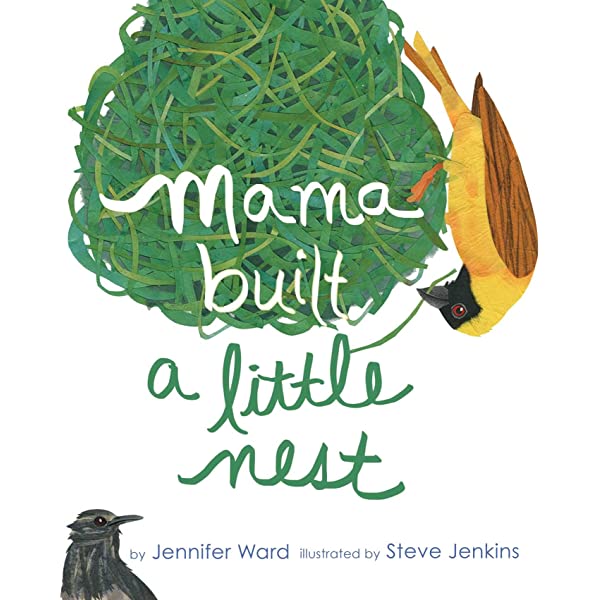This month's Book Nook topic is...
Introducing Rare Vocabulary with
Mama Built a Little Nest

When a child first hears a rare word, they may have a limited understanding of what it really means. Helping a child develop an understanding of rare words builds their vocabulary and will have an immense impact on their reading and writing abilities later on. In this Book Nook, we’ll share some helpful strategies to introduce and explain rare words to children.
Let’s get started!
The Book:
Mama Built a Little Nest by Jennifer Ward
A word about rare words
Selecting books with rare words means looking beyond typical words in daily conversation to find words that are specialized and may be focused on a specific topic. For example, “fall” could be a common word children see in books. However, you might also come across more sophisticated words like “plunge” or “collapse”. To truly make sense of new vocabulary, rare words need to be highlighted and explained.
Why we chose it
This delightful rhyming story explores a variety of birds who are making their nests. Rare words are used to illustrate the different kinds of nests. Along with the story, each page has a few sentences explaining interesting facts. Some rare words in this story are: “bunk”, “ledge”, “indentation”, “hollow”, and “burrow”. Because we don’t typically hear these words used in everyday conversation, exposure to this language through a special-interest book expands the child’s knowledge and vocabulary.
Shoot for the SSTaRS
At The Hanen Centre, we talk about making new words “sparkle”, or stand out, by using a strategy called “Shoot for the SSTaRS”. SSTaRs is an acronym that stands for: Stress, Show, Tell, Relate and Say it again.
Let’s shoot for the SSTaRS with “burrow.”
Stress
You can make “burrow” stand out from the other words by saying it louder and slower than the rest of the text. You can also pause before and after saying the word.
Show
You can show what a word means by pointing to an illustration, showing a picture or prop, or perhaps using facial expression. In Mama Built a Nest you could point out the picture of the owl’s “burrow”.
Tell
You can give the child a short definition of the word burrow. You could say, “a burrow is a hole or tunnel that an animal digs to live in or to hide. Many different animals dig burrows as shelter from weather that is too hot or too cold. Animals also make burrows to hide from other animals or to have a safe place to sleep or have babies.”
and Relate
You can relate the new word to the child’s knowledge and experience. You can also help the child to make connections about how the new word relates to other words. This will make the word more relevant to them and they will be able to apply it in other situations. You could relate burrow by saying something like “Do you remember when we saw some crabs at the beach, and they dug holes in the sand and covered up? They were making burrows”.
Say it again...!
Re-reading a story increases familiarity and helps solidify the child’s learning. The more a child hears and discusses a new word, the better they will understand it, and be able to use it. Repeat the word by re-reading the book, and by using it in other situations. For example, if you see a bunny or snake outside, you could say “I wonder where their burrow is?”
There are so many rare words in Mama Built a Nest. You can re-read this story many times and shoot for the SSTaRS with burrow and other rare words every time you read.
The first time you read the book
Introduce only a few new vocabulary words by using SSTaRS to stress, show and tell the words. Keep your explanations brief so that the story continues to flow smoothly.
The second time you read the book
Continue to highlight the vocabulary introduced in the first reading, while adding more description and details. Include opportunities to relate the word to the child’s knowledge and experiences. Ask open-ended questions to encourage conversation around the new vocabulary.
The third time you read the book
Continue to use SSTaRs by deepening the child’s understanding and relating the new word outside of the story. Consider other activities or pretend play where you can say the word again. With Mama Built a Little Nest, you could:
- use felt pieces to act out the story
- make a burrow with the child out of furniture and blankets
- make a burrow out of playdough for some plastic animals
On the third reading, you can also begin to introduce new rare words.
Happy Reading!
More Resources
The strategies in this Book Nook post are drawn from Hanen’s practical, research-based guidebooks for building emergent literacy. Explore the links below to learn more about how these guidebooks can support you.
For Parents I'm Ready! guidebook
I'm Ready! guidebook
For Educators ABC and Beyond guidebook
ABC and Beyond guidebook
